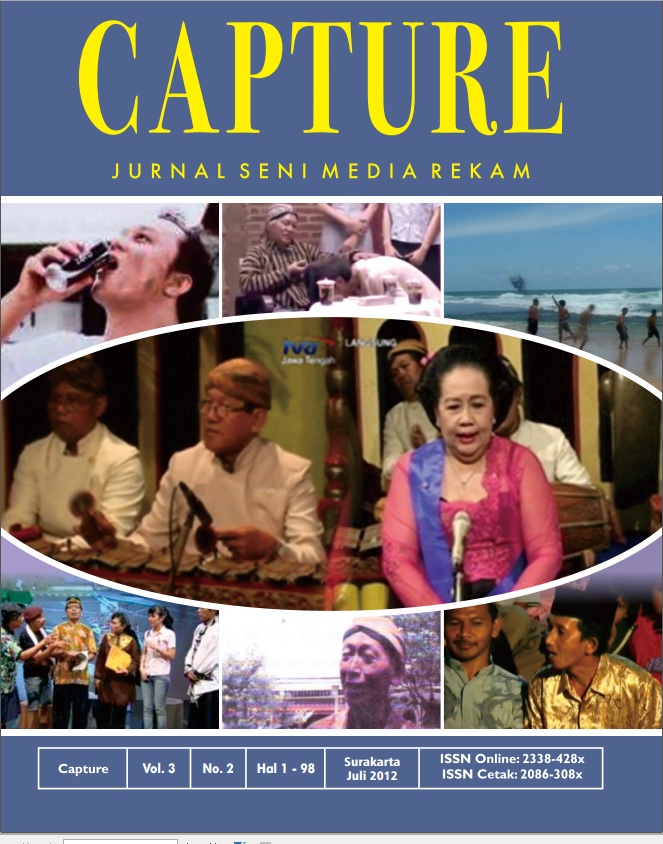STRATEGI PROGRAM TVRI JAWATENGAH DALAM MENINGKATKAN KUALITAS MELALUI KONTEN BUDAYA PADA TEPOTULODHO
DOI:
https://doi.org/10.33153/capture.v3i2.1887Abstract
The background of this research is based on today problems of TVRI station bothintegral and influence quality programs.The aim of the research is to know whatTVRI strategies
to upgrade the quality which has locality content function in the Tepo Tulodho programs.This
research use qualitative descriptive method to dig up the empirical phenomenon in TVRI,
Central Java.In addition,there are three sources: informant,document,and book.To complete
the data, this research uses observation, interview, and documentation.The research results
showed thatTVRI used dynamic pattern in strategy program. Program production was more
dominate than acquisition. Supervision and program evaluation applied by Evaluation Meeting
Press. Strategy of locality culture in the TepoTulodho program described Javanese culture and
one of the supporting of pictured strategy.
Keywords:Program strategy, local culture, picturisation, and rtistic design.
Downloads
References
Afifuddindan Beni.2009. Metodologi Penelitian Kualitatif.Bandung:CV Pustika Setia.
Ary Poernomo H.S. 2004. Strategi Bauran Promosi di TVRI Jawa Tengah dalam Rangka Menjalankan Fungsinya sebagai Televisi Publik. Tesis
Pascasarjana Ilmu Komunikasi UNS. Surakarta.
Bibit Waluyo.2010.“LPP TVRI Stasiun Jawa Tengah Memberi yangTerbaik untuk Pemirsa†dalam Monitor,edisi 18.
Darwanto SS. 2007.Televisi Sebagai Media Pendidikan. Yogyakarta: Pustaka Pelajar.
________1994.Produksi Acara Televisi, Yogyakarta:DutaWacana Press.
________2007.Teknik Produksi ProgramTelevisi. Yogyakarta:Pinus Book Publisher.
Gregory H. Waston.1997.Strategic Benchmarking (Mengukur Kinerja
Perusahaan Anda Dibandingkan PerusahaanTerbaik Di Dunia). Jakarta:PT Gramedia Pustaka Utama.
Hariono. 1996.Pemahaman Kontekstual Tentang Ilmu Budaya Dasar.
Yogyakarta:Kanisius.
Hariono.2009.“Tahun Produksi 2009â€,dalam Monitor,edisi 1.
H.B Sutopo. 2006. Metode Penelitian Kualitatif (Dasar Teori dan Terapannya dalam Penelitian). Surakarta: Sebelas Maret University Press.
Husein Umar.2003. Strategic Management in Action.Jakarta:PT Gramedia Pustaka Utama.
Morrisan M.A. 2008. Manajemen Media Penyiaran. Jakarta: Kencana Prenada Media Grup.
Naratama. 2004. Menjadi Sutradara Televisi. Jakarta: PT Gramedia Widiasarana Indonesia.
Onong Uchjana. 1993. Televisi Siaran dan Praktek.Bandung:Mandar Maju.
Peraturan Pemerintah, Nomor 11 Tahun 2005, tentang penyelenggaraan penyiaran Lembaga Penyiaran Publik.
Peter Salim dan Yenny Salim.1993. Kamus Bahasa Indonesia Kontemporer.
RM Soenarto. 2007. ProgramaTelevisi. Jakarta: FFTV-IKJ Press
Sondang P. Sagian. 1996. Fungsi-Fungsi Manajerial,Jakarta:Bumi Aksara.
Sony Rusonly. 2002. Manajemen Berita Daerah TVRI Bandung Dilihat dari Proses Pengolaan Berita Pasca Perubahan Status TVRI sebagai Perjan.
Skripsi Fakultas Ilmu Komunikasi UNS.Surakarta.
Sunarmi, dkk.“Buku Panduan Tugas Akhir Karya Seni dan Skripsiâ€. Surakarta: Fakultas Seni Rupa dan Desain,
Institut Seni Indonesia,2009.
Sutarto.2004.Menjinakkan Globalisasi tentang Peran Strategis Produk-Produk Budaya Lokal.Jember:Kompyawisda.
Wahyu dan Diki.2010. How To Become A C a m e r a m a n . Yo g y a k a r t a : Interprebook.
Amanu Romly, 55 tahun, Semarang, Kepala Seksi Bidang Program LPP TVRI Jawa Tengah
Budi Wiyono, 51tahun, Semarang, Produser acara â€Tepo Tulodho†LPP TVRI Jawa Tengah.
Djoko Susanto, 53 tahun, Semarang, Pengisi acara â€Tepo Tulodho†LPP TVRI Jawa Tengah.
Dwijanto,53 tahun,Semarang,Produser LPP TVRI JawaTengah.
Yuniarso, 49 tahun, Semarang, Program Director Umum LPP TVRI Jawa Tengah.
Downloads
Published
Issue
Section
License
Copyright (c) 2019 Firdaus Azwar Ersyad, Fitri Murfianti

This work is licensed under a Creative Commons Attribution-ShareAlike 4.0 International License.
Copyright
Authors who publish with Capture: Jurnal Seni Media Rekam agree to the following terms:
- Authors retain copyright and grant the journal right of first publication with the work simultaneously licensed under a Creative Commons Attribution License (CC BY-SA 4.0) that allows others to share the work with an acknowledgment of the work's authorship and initial publication in this journal.
- Authors are able to enter into separate, additional contractual arrangements for the non-exclusive distribution of the journal's published version of the work (e.g., post it to an institutional repository or publish it in a book), with an acknowledgment of its initial publication in this journal.







